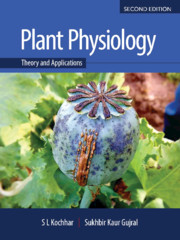Book contents
- Frontmatter
- Contents
- Foreword
- Preface to the Second Edition
- Preface to the First Edition
- Acknowledgements
- Some Common Abbreviations used in the Text
- Abbreviations for Units
- Unit I Water and Mineral Translocation in Plants
- Unit II Metabolism and Bioenergetics
- Unit III Growth and Development
- Unit IV Physiological Stress and Secondary Metabolites – Their Role in Metabolism
- Unit V Crop Physiology – An Innovative Approach
- Unit VI Breakthroughs in Plant Physiology
- Unit VII Some Experimental Exercises
- Glossary
- References
- Index
- Colour Plates
Chapter 12 - Sulphur, Phosphorus and Iron Assimilation in Plants
Published online by Cambridge University Press: 12 May 2020
- Frontmatter
- Contents
- Foreword
- Preface to the Second Edition
- Preface to the First Edition
- Acknowledgements
- Some Common Abbreviations used in the Text
- Abbreviations for Units
- Unit I Water and Mineral Translocation in Plants
- Unit II Metabolism and Bioenergetics
- Unit III Growth and Development
- Unit IV Physiological Stress and Secondary Metabolites – Their Role in Metabolism
- Unit V Crop Physiology – An Innovative Approach
- Unit VI Breakthroughs in Plant Physiology
- Unit VII Some Experimental Exercises
- Glossary
- References
- Index
- Colour Plates
Summary
Sulphur Metabolism
Sulphur is an essential macronutrient for all living organisms, and it occurs in nature in different states of oxidation as a component of inorganic and organic compounds. The chief inorganic form of sulphur, sulphate, is obtained predominantly from the weathering of parent rock material. Natural organic sulphur compounds include gases such as hydrogen sulphide, dimethylsulphide and sulphur dioxide, which are discharged into the air both by geochemical processes and by activity of the biosphere. In the gaseous phase, sulphur dioxide (SO2) reacts with a hydroxyl radical and oxygen to form sulphur trioxide (SO3) which upon dissolving in water produces a strong sulphuric acid (H2SO4), the major source of acid rain. A high concentration of sulphate is also found in the oceans (approximately 26mM or 2.8 g L-1). Plants have a capacity to metabolize sulphur dioxide absorbed in the gaseous phase through their stomata. A prolonged exposure of nearly more than eight hours to high atmospheric concentrations of SO2 (i.e. more than 0.3 ppm) tends to damage plant tissues extensively due to formation of sulphuric acid.
Sulphate uptake and transport
Sulphate enters a plant from the soil solution, primarily through the roots by an active proton cotransport. Sulphate uptake is generally inhibited by the presence of anions such as selenate, molybdate, and chromate anions, which can compete with sulphate for binding to the transporters. Sulphate uptake systems can be classified as either sulphate permeases or facilitated transport systems. Plant sulphate permeases are similar to fungal and mammalian co-transporters. They consist of a single polypeptide chain with 12 transmembrane domains, characteristic of cation/solute transporters. A second mechanism, ATP-dependent transport, is exemplified by a system in cyanobacteria that includes a multiprotein complex of three cytoplasmic membrane components and a sulphate-binding protein in the periplasmic space.
Roots take up sulphate from the soil via electrogenic- symporters (SULTRs). Two high-affinity transporters are expressed in root epidermis and cortex. Although sulphate assimilation occurs in roots, most of the sulphate is transported to the shoots. In photosynthetic cells, sulphate can be translocated either into chloroplasts for assimilation, or into the vacuoles for storage. It has been found that leaves are usually more active in assimilation of sulphur as compared to roots, perhaps because photosynthesis supplies reduced ferredoxin, and photorespiration produces an amino acid serine, which might activate the synthesis of O-acetylserine.
- Type
- Chapter
- Information
- Plant PhysiologyTheory and Applications, pp. 374 - 387Publisher: Cambridge University PressPrint publication year: 2020



